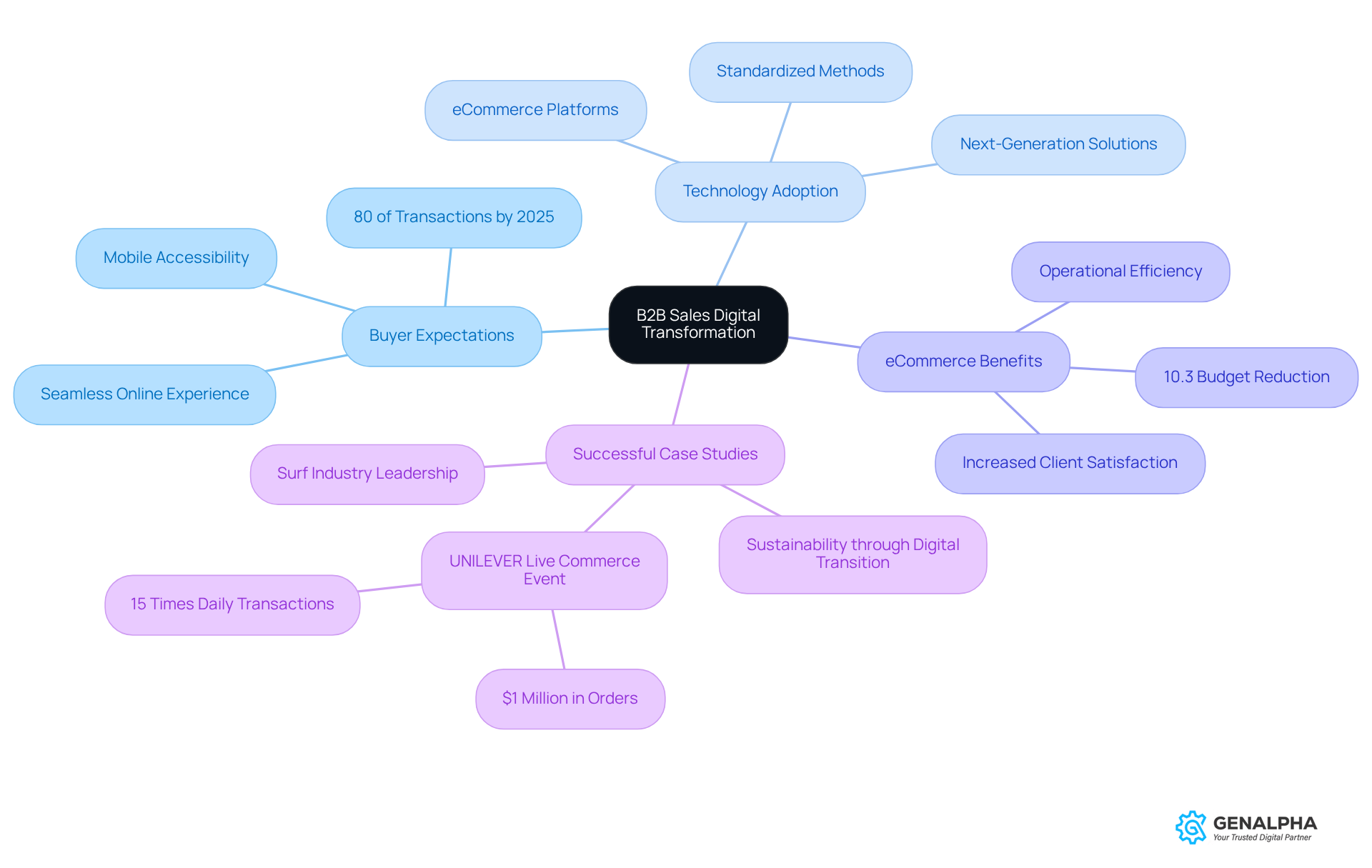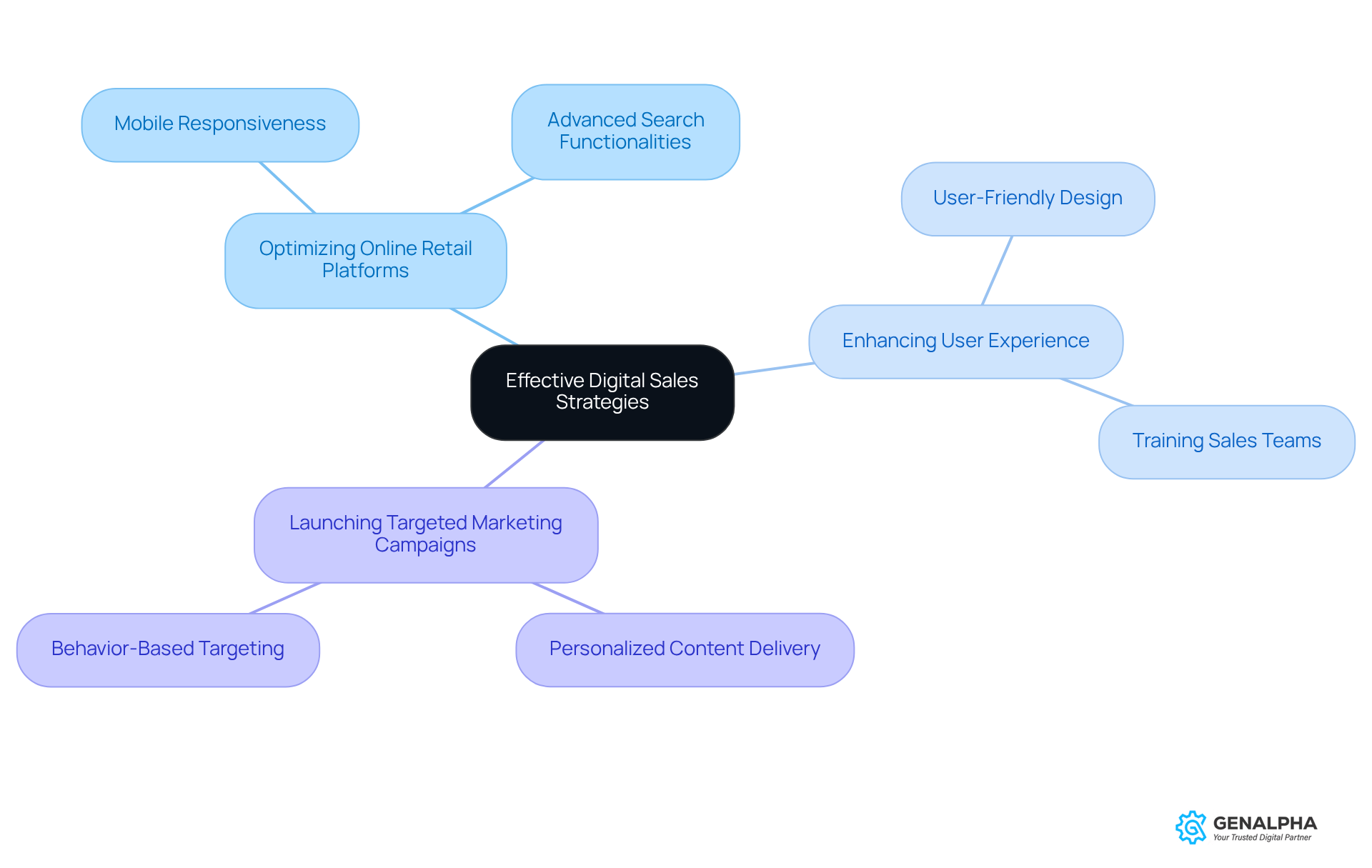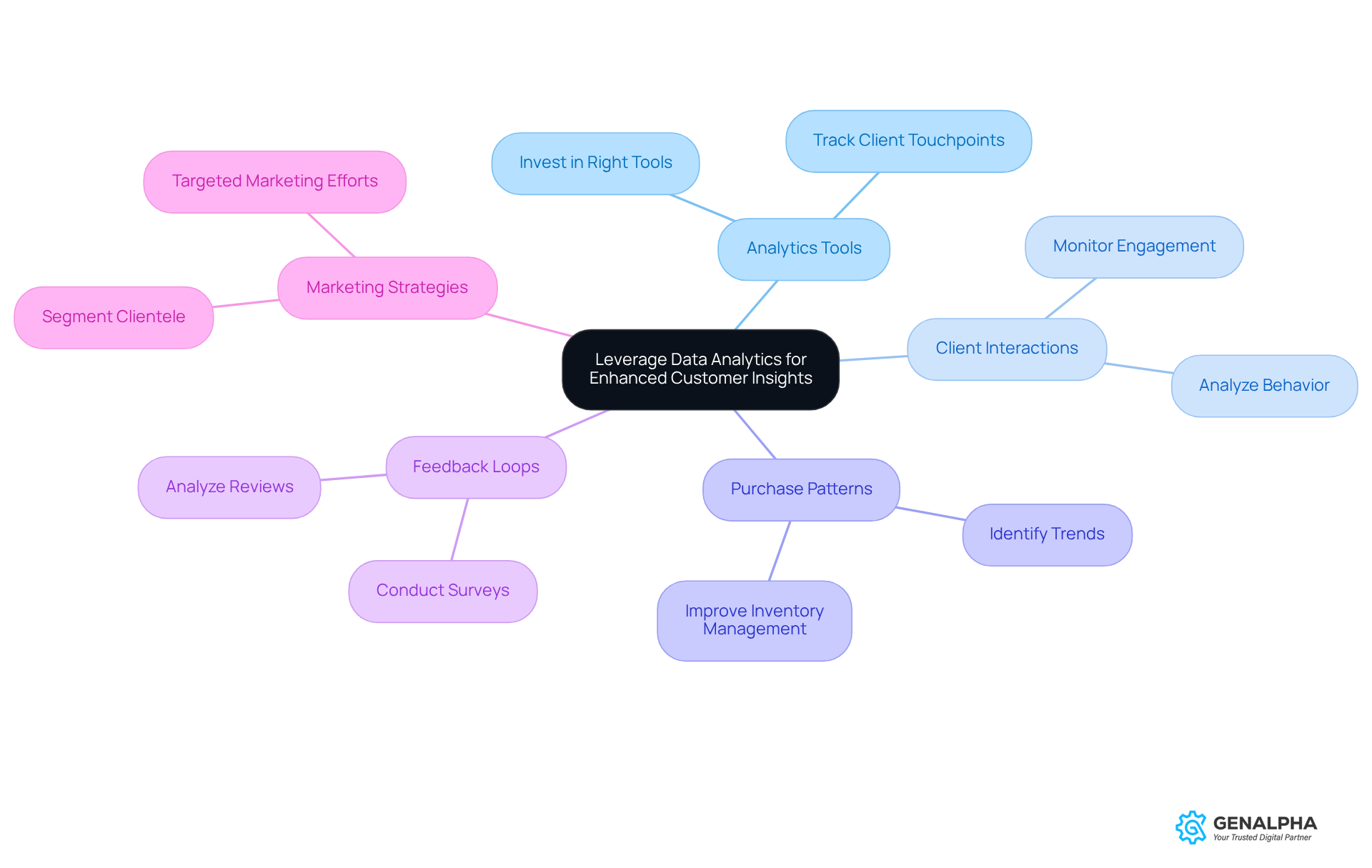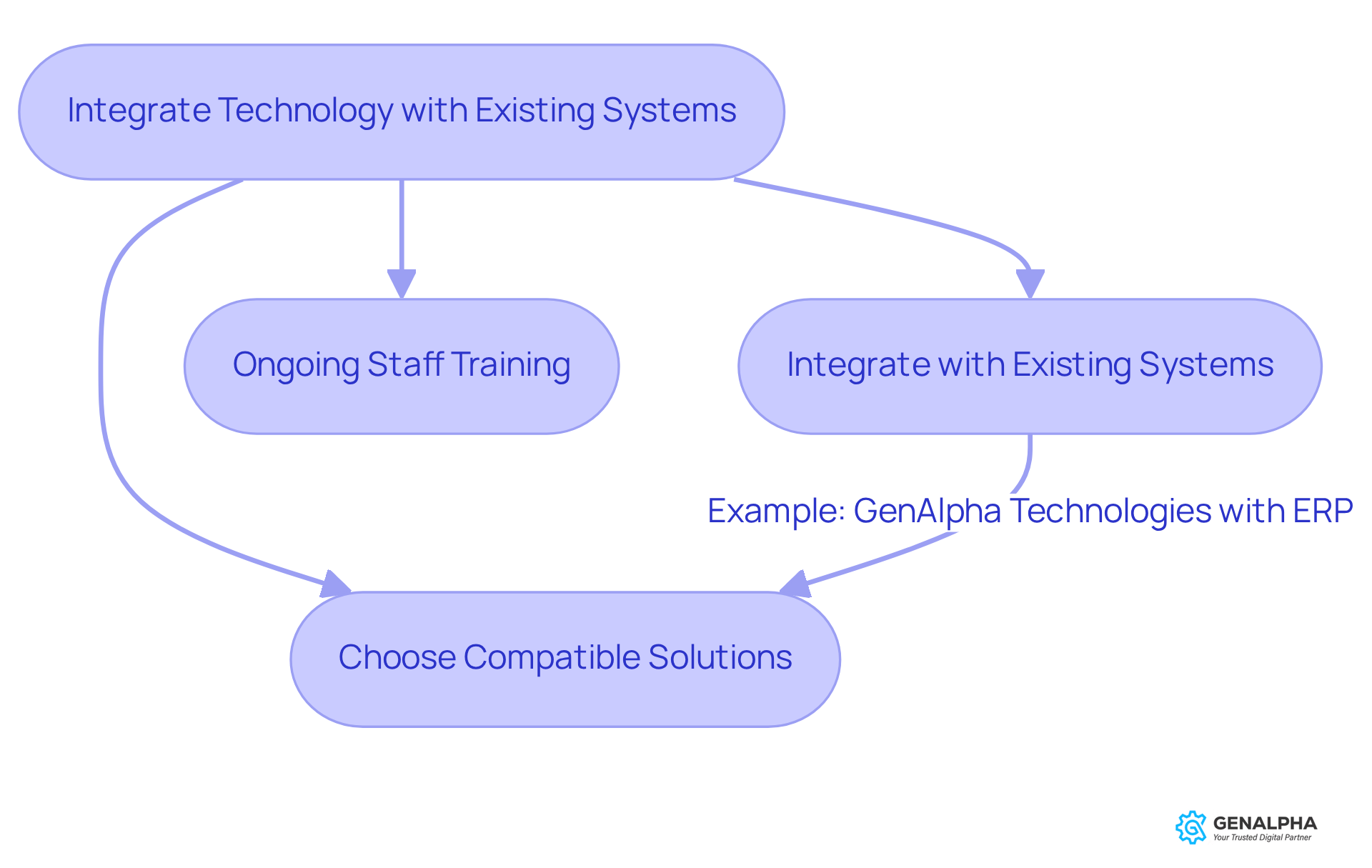Overview
Have you ever thought about how mastering B2B sales can be transformed in today’s digital world? This article dives into just that, focusing on proven strategies that not only enhance customer interaction but also boost operational efficiency.
Think about it: adopting eCommerce platforms, leveraging data analytics, and integrating technology with your existing systems are no longer optional. They’re essential! As buyer expectations evolve, companies must adapt to keep up and improve their sales performance in this fast-paced digital landscape.
So, how can you get started? First, consider the impact of these strategies on your business. For example, implementing an effective eCommerce platform can open new avenues for customer engagement and sales. Additionally, utilizing data analytics helps you understand your customers better, tailoring your approach to meet their needs.
Ultimately, the goal is to create a seamless experience that resonates with your audience. Are you ready to take action and embrace these changes? Let’s explore how you can implement these strategies to not just survive, but thrive in the digital age!
Introduction
The landscape of B2B sales is really changing, isn’t it? With digital transformation speeding ahead and buyer expectations evolving, companies are finding themselves in a whole new world. This shift presents an incredible opportunity to boost customer engagement and streamline operations like never before. But here’s the big question: how can organizations tap into technology and innovative strategies to not just keep up, but actually thrive in this competitive market?
Let’s think about it. As we navigate this new terrain, it’s essential to consider how we can leverage these changes to our advantage. What if we could turn these challenges into stepping stones for success? The possibilities are exciting, and they call for a fresh approach.
So, how do you feel about diving into this journey together? Let’s explore how to harness these trends and make the most of the opportunities ahead!
Understand the Digital Landscape in B2B Sales
The changes in the B2B sales environment are largely due to the B2B sales digital transformation driven by technology. Nowadays, buyers expect smooth online experiences just like they get in B2C interactions. This shift means that manufacturers and distributors need to adapt to stay competitive during the B2B sales digital transformation. Have you noticed how more people are relying on digital channels for research and purchasing? By 2025, it's estimated that around 80% of B2B transactions will take place as a result of B2B sales digital transformation! Plus, mobile accessibility is crucial since more consumers are using their smartphones to make purchasing decisions. Personalized experiences are becoming the norm, and they’re key to boosting customer loyalty.
Organizations that have embraced eCommerce platforms are seeing impressive results in client satisfaction and are experiencing a B2B sales digital transformation. For example, companies that have shifted to online merchandising have reported a 10.3% reduction in combined marketing and service budgets, which really helps improve operational efficiency. And let’s not forget about live commerce events! Brands like UNILEVER have shown that engaging clients through innovative online strategies can lead to remarkable success; they achieved $1 million in orders during a campaign, which is 15 times their usual daily transactions.
So, how can companies thrive in this evolving landscape? It’s all about enhancing strategies and leveraging technology to boost customer interaction and streamline processes through B2B sales digital transformation. This means adopting standardized methods for the B2B sales digital transformation, which not only improves operational efficiency but also aligns with sustainability goals by reducing reliance on printed materials. As technology continues to transform the industry, being adaptable and innovative will be key to success in the B2B sector. What steps are you considering to keep up with these changes?

Implement Effective Digital Sales Strategies
To nail efficient online selling strategies, companies should focus on a few key areas:
- Optimizing their online retail platforms
- Enhancing user experience
- Launching targeted marketing campaigns
Have you ever wondered how an online storefront can make or break a sale? Well, companies can really up their game by ensuring their sites are user-friendly, mobile-responsive, and packed with advanced search functionalities.
For example, think about how marketing automation tools can deliver personalized content to potential buyers based on their behavior and preferences. This is where the magic happens! A case study from a well-known manufacturer showed that by integrating a strong eCommerce solution, they boosted their online revenue by 40% in just six months. That’s a powerful testament to the impact of a well-executed online sales strategy.
But it doesn't stop there! Training sales teams to effectively use digital tools is crucial for the b2b sales digital transformation, as it can significantly improve their interactions with clients and help them close deals more efficiently.
So, what are you waiting for? Let's dive into these strategies and see how they can transform your online selling game!

Leverage Data Analytics for Enhanced Customer Insights
Have you ever thought about how data analytics can really change the game for businesses? By diving into the numbers, companies can gain valuable insights into their clients, allowing them to make smart decisions that truly meet client needs. It’s all about investing in the right analytics tools that keep track of client interactions at various touchpoints. This way, you get a full picture of buyer behavior.
For example, take a look at how analyzing purchase patterns can reveal trends that help with inventory management. There’s a fascinating story about a distributor that harnessed data analytics to segment its clientele. This strategy led to targeted marketing efforts that boosted engagement and conversion rates by an impressive 25%!
But that’s not all. Implementing feedback loops through surveys and reviews can also bring in valuable insights about customer satisfaction. This feedback is crucial for continuously improving service delivery.
So, how can your business start using data analytics to enhance client relationships and drive success?

Integrate Technology with Existing Systems
Integrating new technologies with existing systems, such as ERP and CRM platforms, is crucial for maximizing the benefits of B2B sales digital transformation. Have you ever thought about how important it is to choose solutions that fit well with what you already have? This can really help avoid any disruptions in your business operations.
For example, GenAlpha Technologies provides online retail solutions that work seamlessly with current ERP systems. This means you can manage inventory and process orders in real-time, which is pretty awesome! A manufacturing client even shared a case study showing that after they linked their eCommerce platform with their ERP system, they cut down order processing time by 30%. That’s a significant boost for customer satisfaction!
But it doesn’t stop there. Companies should also think about ongoing training for their staff. This ensures everyone is ready to make the most of these integrated systems, promoting a culture of adaptability and continuous improvement. So, what steps are you taking to ensure your team is equipped for this digital journey?

Conclusion
The evolution of B2B sales through digital transformation isn’t just a trend; it’s a must if you want to stay competitive in today’s fast-paced marketplace. Have you noticed how buyer expectations are shifting? They’re now looking for seamless, personalized online experiences, much like what we see in B2C interactions. Embracing this change means adopting smart strategies that harness technology, optimize user experiences, and boost customer engagement.
Key insights from our discussion show just how crucial it is to integrate eCommerce solutions, tap into data analytics, and make sure your teams know how to use these tools effectively. By fine-tuning online platforms and running targeted marketing campaigns, businesses can really ramp up their sales performance and customer satisfaction. Plus, getting a grip on client behavior through data analytics can lead to smarter decision-making, ultimately driving growth and engagement.
As the B2B landscape keeps evolving, it’s not enough just to adapt; we need to innovate. The message is clear: businesses must invest in their digital capabilities and commit to ongoing training and improvement. By doing this, you’ll not only keep up with the transformation but also set yourself up for long-term success in a digital-first world. Embracing these changes today will lay the groundwork for a more efficient, responsive, and customer-centric future in B2B sales. So, are you ready to take that leap?
Frequently Asked Questions
What is driving the changes in the B2B sales environment?
The changes in the B2B sales environment are largely driven by the B2B sales digital transformation, which is influenced by technology and the increasing expectation of smooth online experiences from buyers.
How is buyer behavior changing in B2B sales?
Buyers are increasingly relying on digital channels for research and purchasing, similar to their experiences in B2C interactions. By 2025, it is estimated that around 80% of B2B transactions will occur as a result of this digital transformation.
Why is mobile accessibility important in B2B sales?
Mobile accessibility is crucial because more consumers are using their smartphones to make purchasing decisions, making it essential for companies to optimize their digital platforms for mobile use.
What role do personalized experiences play in B2B sales?
Personalized experiences are becoming the norm in B2B sales and are key to boosting customer loyalty, as they enhance the overall customer interaction with brands.
What benefits are companies experiencing by embracing eCommerce platforms?
Companies that have adopted eCommerce platforms are seeing improved client satisfaction and have reported a 10.3% reduction in combined marketing and service budgets, which enhances operational efficiency.
Can you provide an example of a successful online strategy in B2B sales?
UNILEVER is an example of a brand that successfully engaged clients through innovative online strategies, achieving $1 million in orders during a campaign, which is 15 times their usual daily transactions.
What strategies should companies adopt to thrive in the evolving B2B landscape?
Companies should enhance their strategies and leverage technology to boost customer interaction and streamline processes. This includes adopting standardized methods for digital transformation to improve operational efficiency and align with sustainability goals.
What is the importance of adaptability and innovation in the B2B sector?
As technology continues to transform the industry, being adaptable and innovative will be key to success in the B2B sector, allowing companies to keep up with changes and meet evolving customer expectations.




